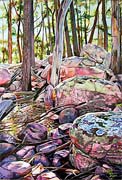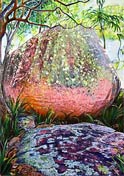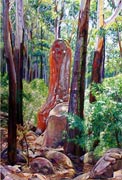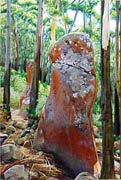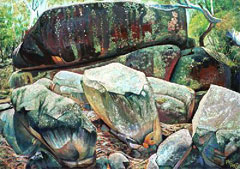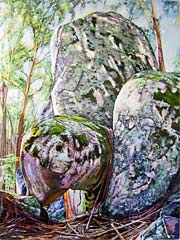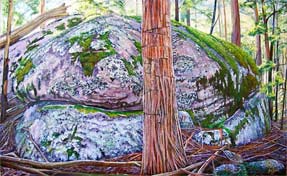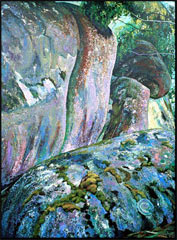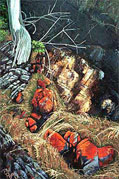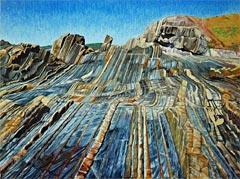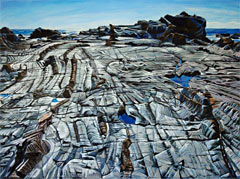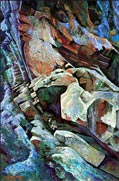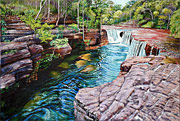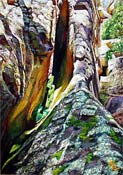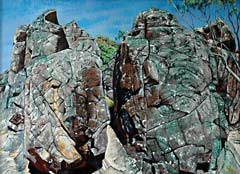Tors and other rock outcrops series
A common approach to landscape art is to stand back and capture the overview or panorama of the landscape often with focus on a majestic mountain range. However it is hard to interact with a panorama. Phil's preference is to inhabit the foreground where you can touch, brush against, or stumble over the landscape. In these Australian landscapes, rock outcrops and tors are the oldest and most important inhabitants.
Granite landscapes
Granite is an igneous rock formed from liquid magma that has cooled slowly at depth below the ground surface and then becomes exposed by erosion.
The slow cooling process enables crystalisation of the magma into component minerals; quartz, mica, feldspar etc. So granitic rock can be very hard, of uniform composition, but with a granular texture. Slow cooling and crystalisation also means that a large granitic body, or batholith, usually develops a large-scale cracking pattern, similar to what is seen as a mud puddle dries out but at much larger scale and in three dimensions.
With erosion and weathering granite bedrock is exposed. Preferential weathering often occurs along the cracking pattern and this results in large exposed round boulders of granite, or "tors". These are a characteristic of most granitic landscapes but the actual size, shape and orientation of the tor field can vary widely due to the type of granitic, its chemistry, age and tectonic history.
For a geologist, a granitic tor is a window into the nature and structure of a whole batholith. For an artist, they are the exposed vertebrae of the landscape, often with fascinating sculptural form and varied surface texture.
Granite tors in Myopic Landscape paintings
Granite tors can have distinctive colours such as Mumbulla Mountain 1 and Mumbulla Mountain 2 and shapes Gulga Duo, Booroomba Rocks and Chawell Galleries:
Tor surfaces are often colonised by various lichens and moss producing wonderful colours and patterns. This can be seen in Booroomba Rocks (shown above), Storm Lookout 2, Storm Lookout 3, Tidbindbilla Tors 1 and Tidbindbilla Tors 2:
Other rock types in Myopic Landscape paintings
Other types of rocks produce distinctively different outcrops and hence different landscapes.
Limestone or karst landscapes are a special example, more details of limestone or karst landscapes can be found in the Karst Country series.
Sedimentary rocks
Sedimentary rocks can have distinct structure and pattern due to their original bedding strata or subsequent tectonic modification, uplift and folding. This can be seem in Red Lichen 1, Wave Cuts Rock 1, Wave Cuts Rock 2, Synclinal Strata and Twin Falls - Eliot River:
Volcanic rocks intrusions
In the Mount Macedon - Hanging Rock area of Victoria, a volcanic rock (trachyte) has intruded older rocks producing several strange formations. These are some of the strangest and evocative rock outcrops Phil has seen:
Camels Hump is one of these formations on top of Mt Macedon but the best known is the close by Hanging Rock (the only volcanic rock outcrop to have its own film) where the outcrops have been described as "mammillary" as seen in his Hanging Rock painting (a possible geological X-rating).
Find out more about Phil's art:


